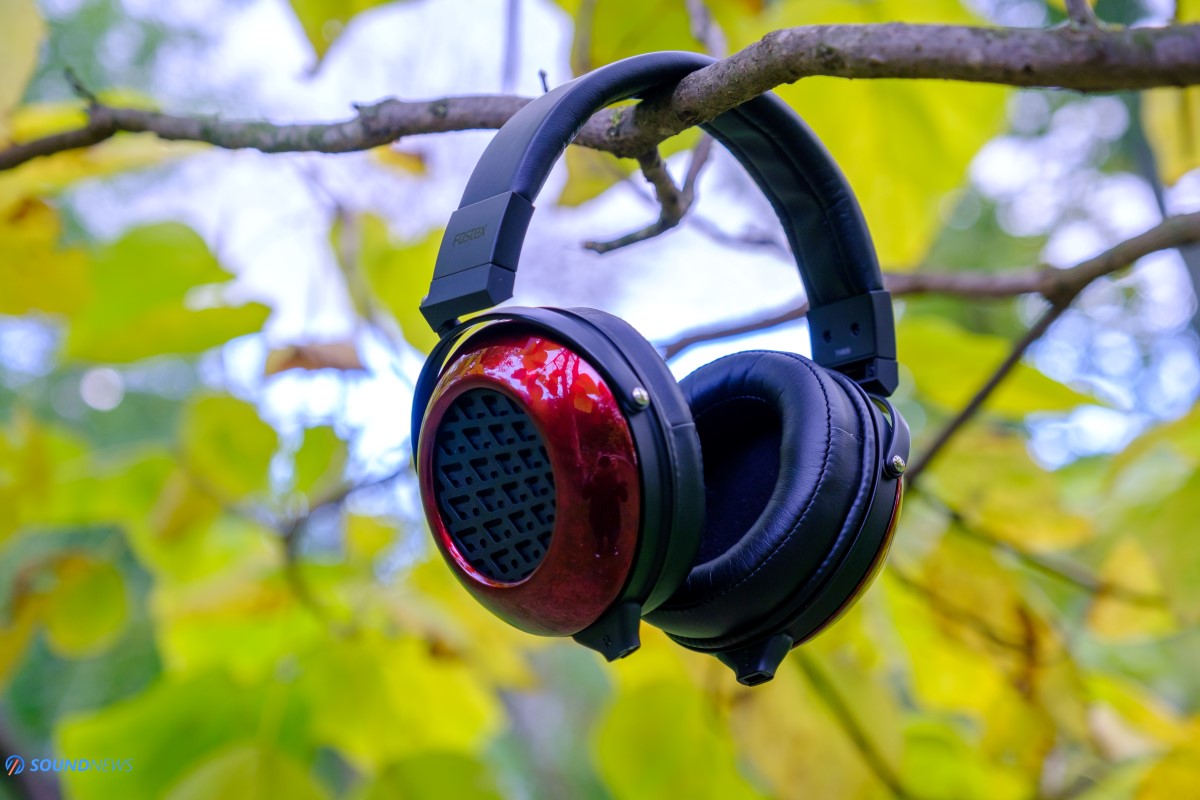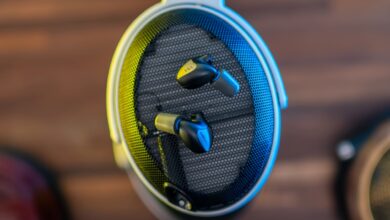Fostex TH909 Review – Fun in its Purest Form!

My Video Review:
I remember going to my first headphone enthusiast meeting, I came with a pair of Audeze LCD-3 in my hands, someone came with top Sennheisers and Grados and the host was rocking a pair of Fostex TH900 for all his music needs. I asked why a closed-back and what is so amazing about them? He winked and suggested that I need to listen to them first and then we could talk about it. Long story short, the most discussed headphone of that evening was the TH900 by Fostex. Prior to that, I strongly believed that LCD-3 had an amazing bass performance, but after comparing the two, it was clear that TH900 was awakening some subterranean bass notes that I never knew were there in my music. We called them disco headphones because they were extremely fun and engaging to listen to. They always had an uplifting effect on us, it was a very toe-tapping headphone with the best bass quantity and quality I’ve heard up to that point.
Years passed and TH900 was already updated to Mark II status, but I always wondered why Fostex is not releasing an open version of their extremely popular closed-back flagship. Not a long time passed and TH909 were released rocking the same Japanese cherry birch ear-cups finished in a beautiful red lacquer, having the same Biodyna diaphragms and of course the same powerful magnets for an unprecedented speed of delivery and impact. The only thing that looked different were the ear-cups that had a metal mesh in the middle that would move a lot of unwanted resonance behind the driver to the outside world. On paper, TH909 should outperform its closed-back sibling, by offering a lower driver distortion and a bigger and wider sound on all axes. I will be conducting a comprehensive review including detailed measurements and I’m very curious about the results.

Unboxing Experience
They came in the largest box I’ve seen thus far; the reason is that besides the headphone box itself, a smaller box near it houses a matte-black wooden headphone stand. It is nicely made, it is slightly taller than usual, so it wouldn’t apply a higher pressure on the headphone connectors. It will safely store and display your Fostex TH-Series headphones and if you wish for some additional stands, you can get them separately, model number is Fostex ST300. The other bigger box is carrying the precious headphone surrounded by lots of foam for protection. A detachable cable can also be spotted, it is a really nice one, I love the heavy-duty metal jacks, the thickness of the cable, its textile outer jacket and that it is free of any microphonics. Fostex is also selling separately the 4-pin XLR version of this cable, part number is ET-H3.0N7BL and it will work with all Fostex TH-Series headphones. A carry bag is in there too, that will protect your headphones during long travels.
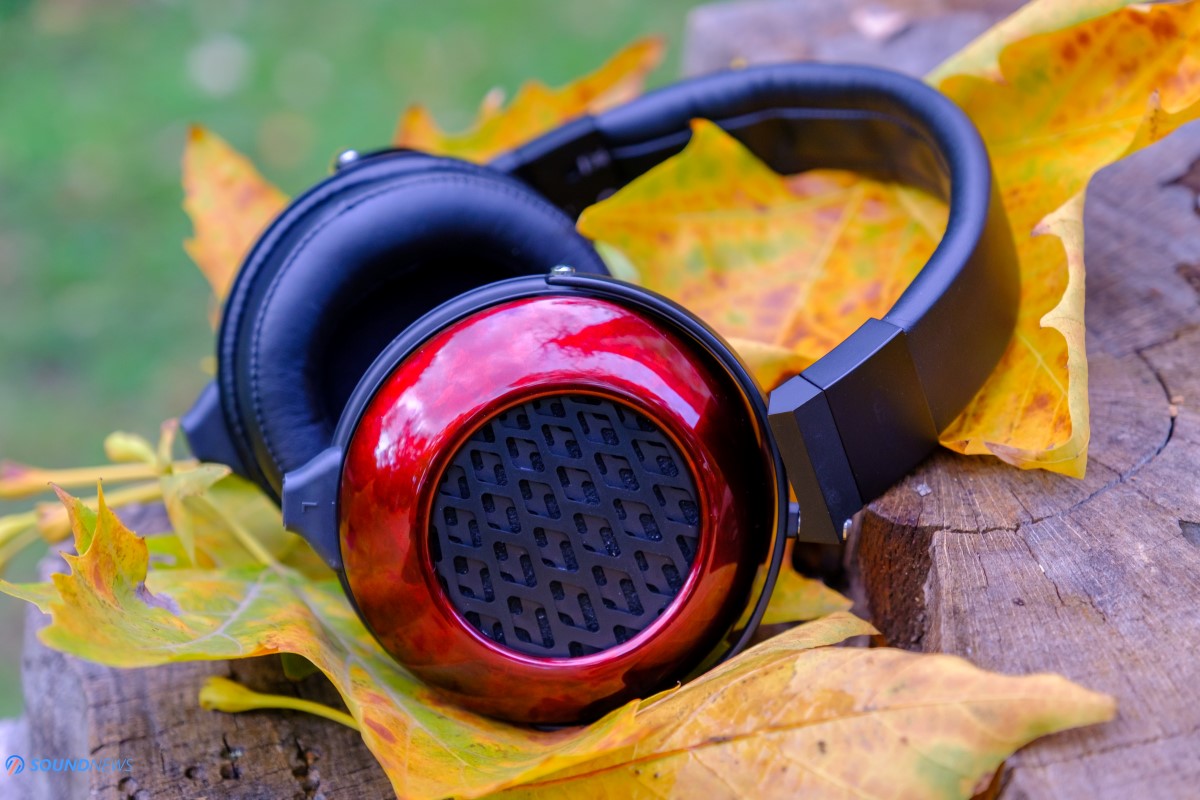
Build Quality & Looks
If you ever experienced a TH-series headphone of Fostex, then you should know that TH909 is having basically the same lightweight frame. This is a huge plus in my book, because while they look big and imposing, their weight sits at only 390 grams that will have a tremendous impact on the comfort levels long term. I’m reminding that Erzetich Phobos and Audeze LCD-4 are weighting around 700 grams and will apply a much bigger force on top of your head. Fostex succeeded in here by using metal only in the most crucial parts of its frame. The headband is quite thin, it doesn’t have a lot of padding and instead is covered with a thin layer of synthetic leather. This shouldn’t worry you too much because the weight distribution is good and I never felt discomfort even after few hours of use. The height adjustment part is metal made, just pull them up and they adjust to your desired position.
The stars of the show are obviously those gorgeous looking ear-cups. Not only did the use one of the rarest woods – Japanese cherry birch, but they also added a very beautiful lacquer Bordeaux finish by craftsmanship of Sakamoto Urushi Factory established in 1900. Just between the wood itself and the lacquer finish, you can spot silver foils that are adding a very nice effect when light is shining at them. If you are curious how that lacquer finish is made, here is a short video showcasing it
These are the most beautiful ear-cups I’ve seen, amazing to look at and they will surely turn heads in a headphone meeting. The ear-pads are detachable and from their whole headphone line, these are having the biggest ear-pad openings, I’m pretty sure people will not have fit issues with these. It’s a newly designed ear-pad, that is also being used in their TH900 Mk2, it adopts a low-resilience cushion to achieve high comfort levels and best audio performance. These are not very deep ear-pads and sometimes your ears could touch the textile material under the pads.
Their look is of course a very subjective thing, but after playing with them for a while, experiencing that high-quality cable and those beautiful looking ear-cups, you can’t be unimpressed by their build and gorgeous looks.
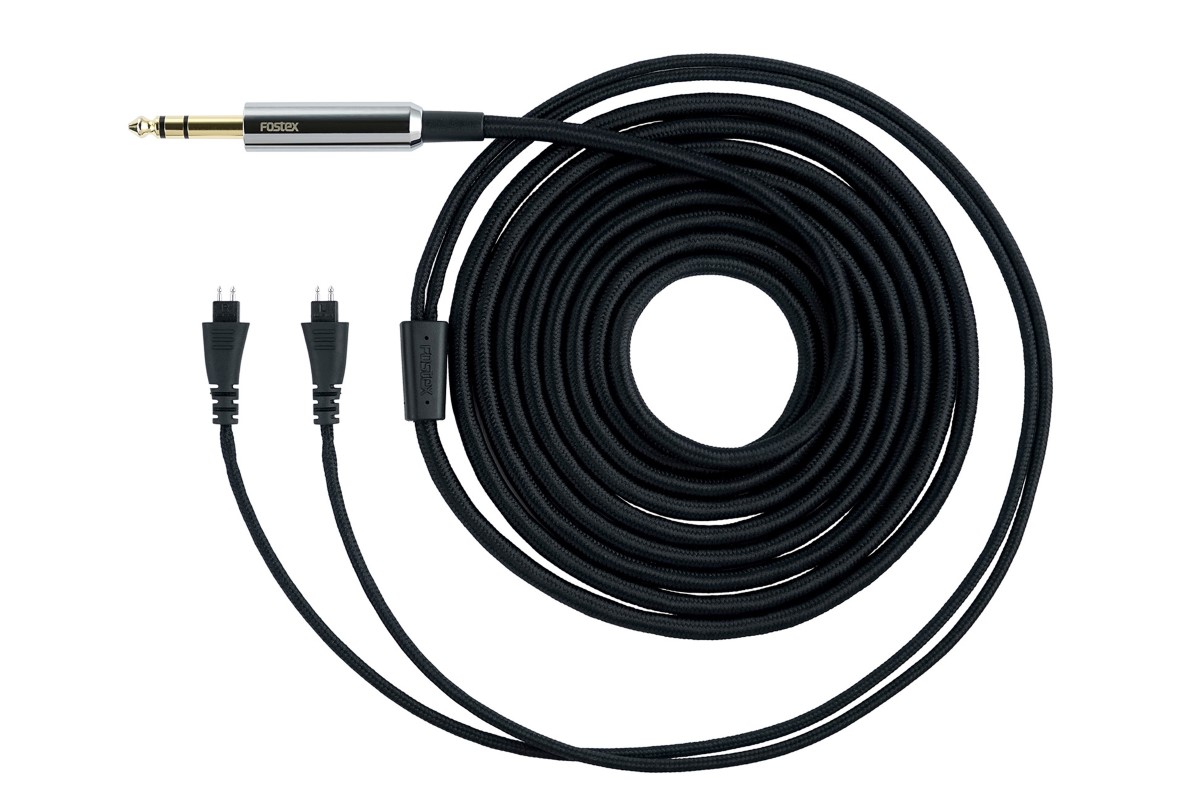
Cable Quality
This is one of the thickest stock headphone cable I’ve experienced and while some might want to upgrade to a better performing cable, I am not recommending doing that. This is not your typical stock cable; it’s far from it. For example, this cable uses Rhodium plated 2-pin connectors and Gold plated 6.35mm headphone jacks for a better resistance to oxidation. The conductor itself is using the highest-grade copper with a purity of 7N. If you want that in numbers, that’s a purity of 99.99999% and it’s also Oxygen Free to repel oxidation long term. The outer mesh is made out of a textile material that is not adding microphonics of any kind. I really like this cable and I wish more stock cables would look and sound as good and resist long term as this one will.
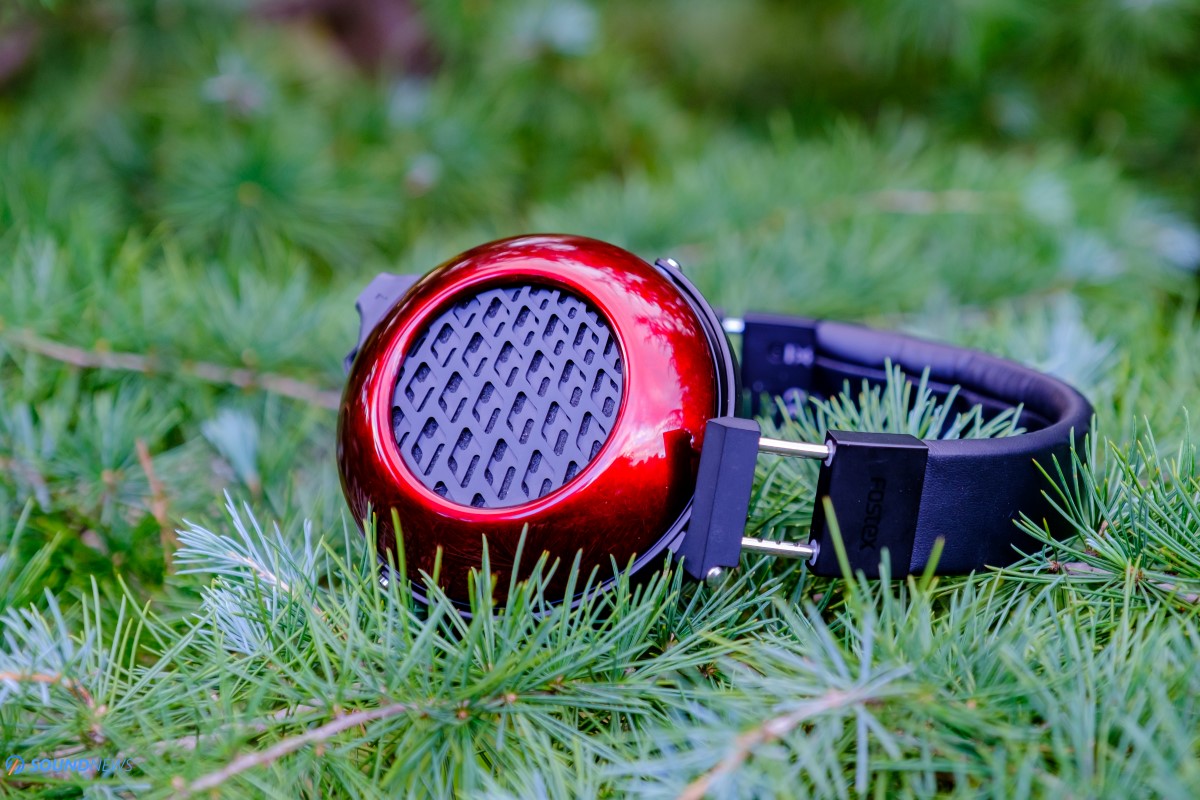
Tech Inside them
First of all, TH909 is a dynamic headphone that is using proprietary 50 mm Biodyna drivers – that are made from a mixture of bio-cellulose and inorganic fiber. Fostex used some of the best magnets to achieve a very-high 1.5 Tesla magnetic flux that should preserve the full force of the transient response and widen considerably its dynamic range.
A combination of two factors like its very low 25-Ohm impedance and its very high sensitivity of 100 dB per 1mW power, made it one of the nicest dynamic driver as you can drive it with pretty much any headphone jack, but more about this very soon.
This is a very strong driver that will resist a lot of stress, more exactly 1800 mW of power short term can be delivered to it. Their declared frequency response is very wide at 5 Hz to 45 KHz, you will need to have some bat ears to hear all that, nonetheless I will be measuring them soon and will see how that goes.
Fostex is also calling them open-back headphones, you can clearly see the double layer structure of the metal grills, which will diversify the resonance points and will move a lot of unwanted acoustic waves outside of the ear-cups. That mesh is pretty cool looking and since there is a thin layer of foam under it, dust particles will not get inside. With a lot of experimentation and music listening I can say that they work more as semi-open headphones, since they are not leaking that much compared to fully open-back headphones as Hifiman Arya or Erzetich Phobos. Okay everyone, I’m ready for some well-deserved music so let’s hit some eardrums!
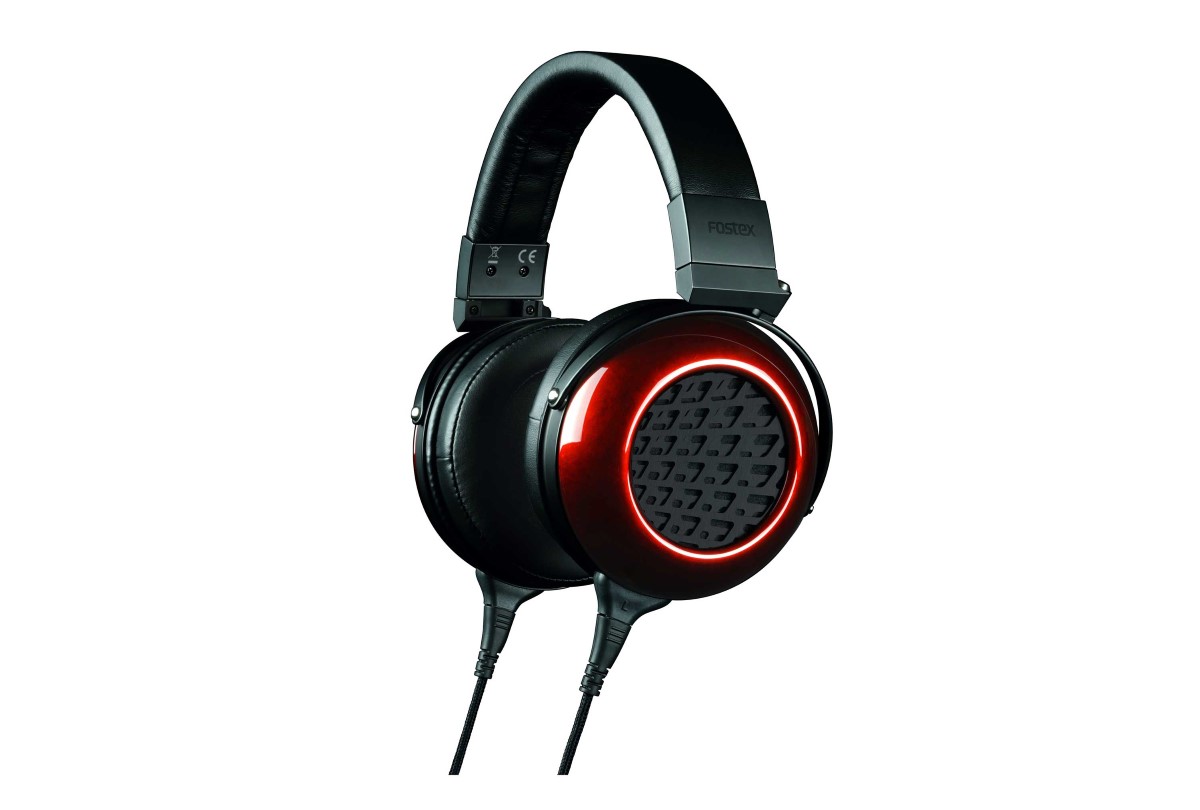
Sound Performance
I. Preliminary Impressions
I forgot how fun and enjoyable headphone listening can be, the amount of positive energy emanating from these drivers is through the roof. I almost can’t believe a pair of dynamic drivers are sitting inside their cups, as the slam and speed they are capable of is truly up there with the best I’ve experienced thus far. I just want to listen to music with these with a stupid smile on my face and not carrying for anything else. These are really engaging and toe tapping open-back headphones, it is like having your own party inside your head always pumping good mood and positive emotions.
There are a lot of headphones that I can use for multitasking while listening to music, but not with TH909. These will demand your utmost attention. While they are not the most resolving headphones I’ve tried, nor the widest and airiest headphones I’ve listened to, I’m pretty sure these are the most fun open-back headphones I’ve heard in a while. There are times when I don’t want to think about the smallest details in my music, about the technical aspects or about the flaws of those recordings. Often times I just want to rock-out and remember the good-old times and I do believe these are very good at offering you that.
These are even harder slamming and more impactful than Quad ERA-1 and Audeze LCD-4 and that tells a lot how I feel about them. Transient response is their second name and everything that is tied to it like speed and slam are simply world-class. I can’t believe so much bass is still lingering somewhere in my tunes.
What was also very obvious from the start is that the open-back version is not lacking that much in the midrange department and that the upper end is detailed, crisp and extended past top-octave. Sub and mid-bass are elevated by few decibels, TH909 are not targeting for absolute linearity or perfect numbers, instead these will move your body and pound your eardrums with an incredible force. They are reminding me a bit about the Kennerton Magni which also sounded extremely engaging and satisfying, but these are turning all its knobs to eleven. TH909 are having a bigger void between the musical notes, I can easily listen to individual notes in crowded tracks, soundstage and depth are actually much nicer than what I was expecting to hear. Soundstage is not exactly huge, open-wide and enveloping, but it’s bigger than that of the Kennerton Magni and Gjallarhorn, OLLO S4X Reference and considerably wider compared to Sennheiser HD6XX line of headphones. With all that said, open-back planar-magnetic headphones will sound by a notch deeper, wider and airier.
What excels on TH909 is actually a combination of multiple factors that together are making them truly special: lightning fast speed, amazing slam in the ear-drums, good transparency and detail retrieval, open sound with a really nice depth, extended frequency response at both ends and of course their high sensitivity that are not adding a lot of pressure on your source and amplification.
I will say it right away that TH909 weren’t made for classical music or for simple acts as closing your eyes, having a drink and relax on some easy-going smooth songs. Fostex TH909 feels more like an untamed wild horse, it’s a race car of the headphone kingdom, it is always testing your nerves, your limits, it wants to go fast, it wants to pound your eardrums with Thor’s hammers and it is really good at it.
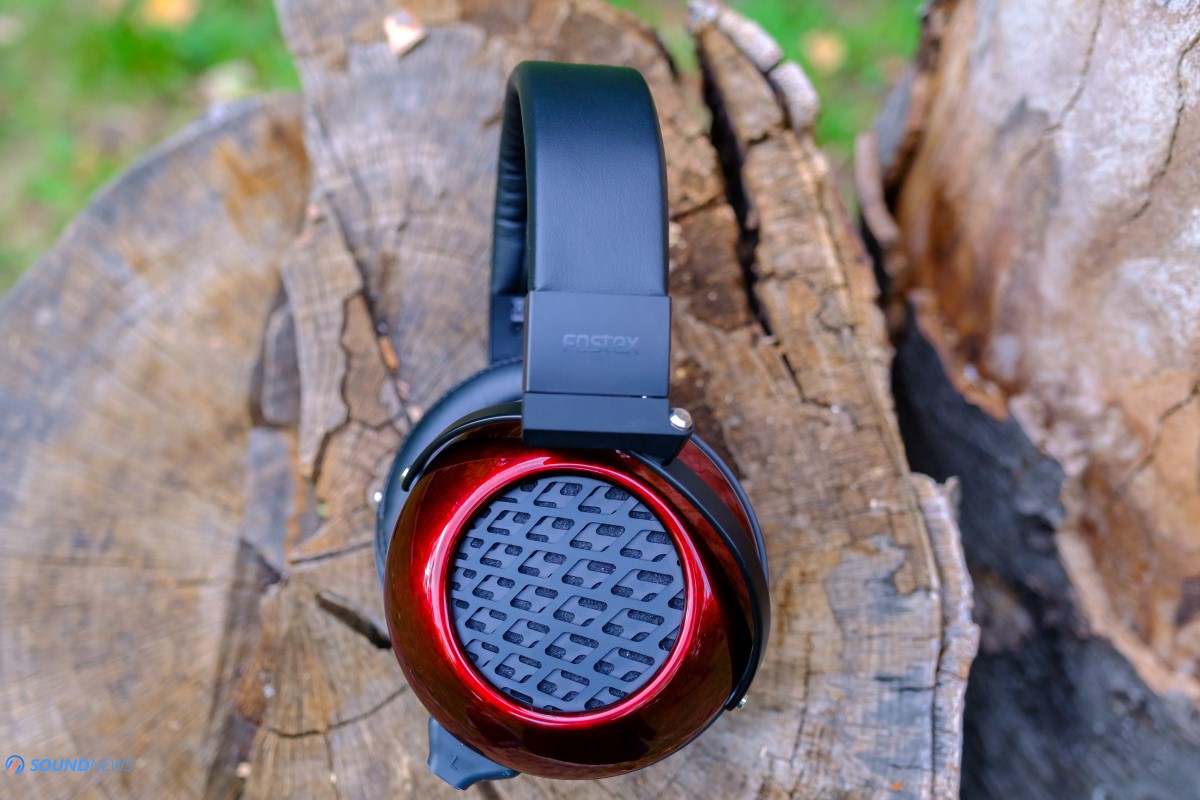
II. Power Requirements
This is quite an interesting chapter, because I can measure their sensitivity myself. If you checked my Kennerton Magni and Kenenrton Gjallarhorn reviews, I called them as the easiest to drive desktop headphones I’ve tried. Their low impedance and super-high sensitivity, made them sound great even out of low powered devices as portable digital audio players, Bluetooth dongles and those sounded decent enough out of smartphones and laptops.
Compared to them, TH909 will need only an additional 2 dB of volume to achieve the same SPL of 85 dB according to the microphones inside the MiniDSP EARS system. It is my pleasure to tell you that TH909 are very easy to drive indeed and on average they will need about 1 dB more to achieve the same SPL of portable headphones as Sennheiser Momentum 2 and Meze 99 Classics. This is quite a big deal, as if you can drive portable over-ear headphones with aplomb and power to spare, then you can drive these as well with a lot of headroom left on tap too. I’m going as far and say that powerful desktop headphone amplifiers will not improve them that much and balanced power is not even mandatory to achieve the best results. If you already have a digital or analog source with a headphone jack on its front plate, then I’m pretty sure it will drive these to very loud levels, awakening the same punchy dynamics I’m experiencing. With a Microsoft Surface Pro 7 laptop, I needed to raise the volume only at 70% for a comfortable listening level of 90 dB. A half-decent portable DAP will have no issues either of driving these at their maximum potential. This is a very big deal actually, because they just transformed in one of the nicest transportable headphones which you can carry around in long or short trips and drive them with a simple Bluetooth dongle like FiiO BTR5, Shanling UP4 or with a portable DAP and have some amazing results.
That soft carry-case will get in handy in such situations, too bad traveling is not something I am looking forward too very soon. From my headphone stable, TH909 are only by 2 dB harder to drive compared to Kennerton dynamic headphones and these are considerably easier to drive compared to the rest of the gang. With them you really don’t need big and heavy amplifiers dissipating a lot of heat. If you will be using them in front of a PC for you music, gaming and multimedia needs, then something like a JDS Labs Atom DAC and Atom Amp ($99 each) will be more than enough. Another option is going for the Topping E30 DAC ($129) and L30 Amp ($139) if you would like to have more power for the rest of your headphone collection.
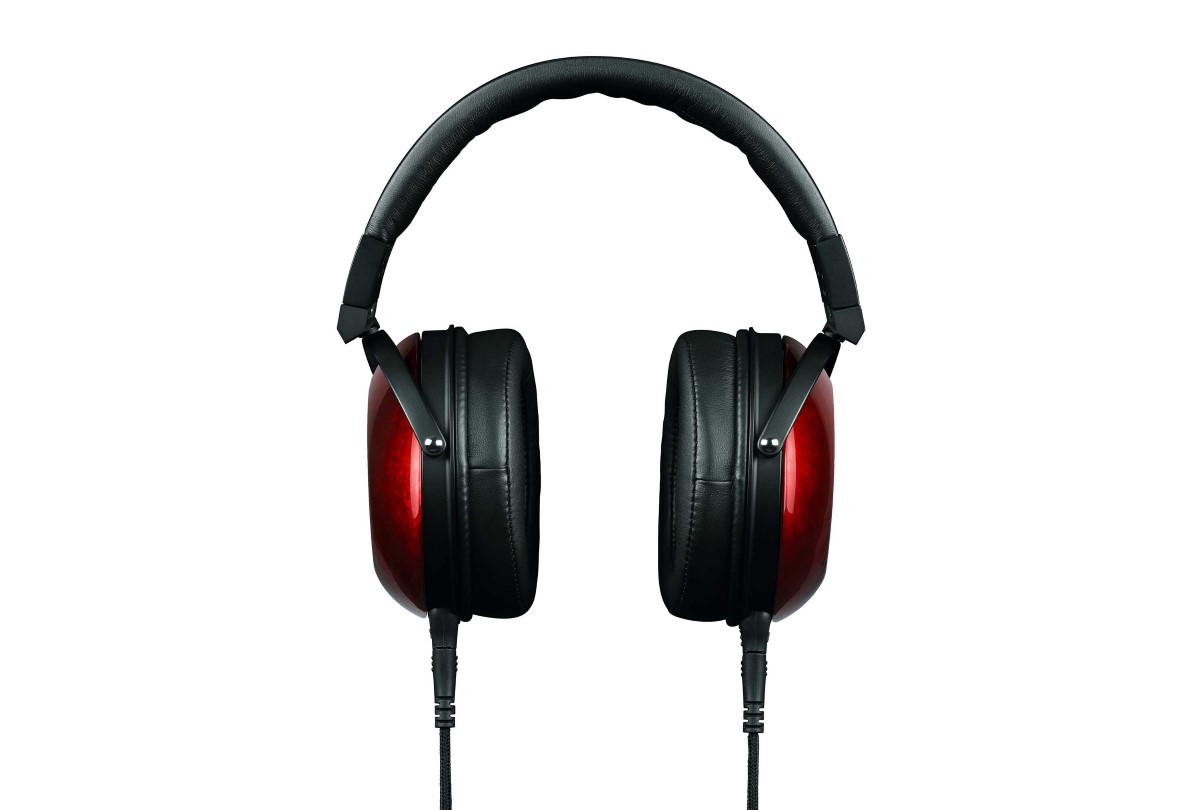
III. Soundstage & Depth
Two weeks ago, I’ve reviewed the Erzetich Mania which is a semi-open headphone and a month before it, Ollo S4X Reference was also put to the test, which is also a semi-open headphone. To some degree TH909 feels like a semi-open headphone too, because not a lot of sounds are leaking outside as it usually happens with open back headphones.
Nonetheless, I didn’t need a lot of time to realize that TH909 is outplaying all the headphones I’ve mentioned above. TH909 are actually reminding me quite a lot about the soundstage of the Hifiman Arya. The Division Bell by Pink Floyd (Tidal / Spotify) is a well mastered album with tons of sounds flying around, sounding outside my head with open-back headphones and lackluster with closed ones. With TH909, the sound enveloped me, guitar strings were heard well separated to my right and then to my left, some sounds were coming from different angles and I felt being the centerpiece. What I want to say is that TH909 will preserve depth information as well as a wider soundstage with well-mastered albums. It wasn’t difficult appreciating that few sounds were closer to me and others much farther away. What impressed me is that, even if I‘m listening at a much lower volume (between 55 to 60 dB) the notes felt exactly as visceral, defined and outlined. I didn’t need to raise the volume to hear the impact of the bass notes, even live music preserved intact its pace, rhythm and timing. Not a lot of headphones can do that. Planar-magnetics for example are not that impressive at low listening volumes and yet, TH-909 were snappy, engaging and wide open even at a low SPL.
When A Blind Man Cries by Deep Purple (Tidal / Spotify) sounded almost disjointed at times, the distance between those drums, guitars and vocals was impressive to say the least. I re-checked if I wasn’t listening to the live version and nope, it was the regular studio version that sounded big and wide on all axes. With music like this, they were able to calm my spirits and induced a relaxed state of mind by slowing down and disconnecting me completely.
As a point of comparison, I find them bigger and wider sounding than the semi-open headphone I’ve tried before like Erzetich Mania, OLLO S4X, they sound much wider compared to the Sennheiser HD6XX line and of course they outperform the horn-loaded Kenenrton Gjallarhorn at their own game, which mind you is not an easy thing to achieve. They are only by a hair less extended in here compared to Meze Empyrean, Audeze LCD-4, Hifiman Susvara, Erzetich Phobos and Kennerton Wodan, but I was expecting that if being completely honest with you. If you want the widest possible sound, TH909 can’t offer you that, they will still sound by a hair closer to the listener, more intimate and cozier and with some particular music I think that works really well.

IV. Transient Response
By Thor’s hammer, holy smokes! I don’t even know where to start this chapter. I will simply say that I’m yet to hear a headphone that is more engaging, more impactful, more mean, more brutal and untamed as these are. Unwillingly, I added more electronica to my playlist, more rock and metal. I wanted to test their limits and they wanted to test mine in return.
If you want to rock-out hard and uplift your day, I don’t know a better remedy than this. A huge dose of dopamine always rushes into my veins when a faster paced song starts playing with TH-909 on my head. While listening to them, I can’t focus or do anything else. I will just stop, toe tap a bit, I will air drum a little and will enjoy the hell out of it until the end. These are not you regular easy-going multitasking headphones. Can you really work when your ear-drums are being kicked like punching bags? I don’t think so. I went all in with my music, I was going faster and faster and no matter how fast it was, TH-909 always kept up with it like it was a walk in the park. I never experienced muddiness, or that they are running out of fuel and dynamics. On the contrary, after a few hours of non-stop action, I needed to take some rest.
TH-909 are fun in its purest form and shape, if rebel-blood is running through your veins, I do think these will rock-out hard and will deliver everything you want from your music. Dynamics and wild transients are pretty much their second names and if this is what are you searching for, I don’t know anything that is harder hitting and more engaging.
Mellower and slower paced music worked well too and they were able to brake and slow down a little, yet if you want to rock-out on Moonlight Sonata by Beethoven (fast movement) you can easily do that with these. Fever by Elvis Presley and My Way by Frank Sinatra preserved the smoothness and liquidity of those tracks. There was an easiness and a flow that was always present in there. However, the faster decay of the notes was observed from the start. With TH-909, all sounds wouldn’t linger a micro-second longer and instead the next note will start playing immediately. I think these will work nicely with slower-paced music, but it’s not their forte, so don’t expect to be completely relaxed with these.
In the end, they want to be wild and they want to go fast, dynamics are through the roof with these. This their nature and they aren’t shy at all about their darker personality.

V. Detail Retrieval & Transparency
There is no denying that TH-909 are clean and transparent sounding most of the time. Their extended frequency response, super-fast nature and shorter decay of the notes are making them appear as having a higher than usual resolution and a top-notch transparency. I’m listening to them for more than 3 weeks now and I’m not shy saying that they are the most detailed dynamic headphones I’ve tried of late. It is not Sennheiser HD800 level, but more like Beyerdynamic T1 level, if you know what I mean. They will even outplay entry to mid-level planar headphones too in this region. Their extremely good upper-treble makes them appear as resolute and detailed sounding and no matter the song, every note feels complete, I’m hearing their entire shape, body and weight. TH-909 always delivered the whole package with some extra-topping on top.
I actually find them more detailed that most headphones I’ve reviewed of late, they will destroy headphones like Meze Empyrean, Audeze LCD-2 and LCD-3, Hifiman Ananda and will come dangerously close to the upper-league of headphones. I never had a feeling that something is missing in here, how I felt on Erzetich Mania. I am hearing layers after layers of information with these, sub-bass and bass information is immaculate, midrange is well-defined and weighty and treble is extra defined and crispy sounding so there isn’t much to complain in this regard.
Smallest micro-details in my music are rendered like macro-details, I don’t need top notch electronics to hear all that and I don’t need to force myself and close my eyes for that to happen. TH-909 will deliver them easily and I’m very happy to experience all this. In all these 3 weeks, I understood that they have some well-designed dynamic drivers that could rival the cleanest sounding headphones. This is a chapter where I don’t even need to exemplify with a few songs just to arrive at the same conclusion. Micro-details can’t hide with a headphone like this, be it in the bass, midrange or treble, TH-909 worked like a magnifying glass for all my music, old and new and there isn’t more to say about it. This headphone reminded me why there is still a huge market for good sounding dynamic headphones and a cult-following for the Fostex TH-line of headphones.

Frequency Response
VI. Bass
I will measure them soon, but even without doing it, I’m pretty sure they have the best sub-bass extension I’ve experienced in headphones. There are so many layers of bass in my tunes, I don’t get it why other reference headphones can’t show as many layers as these can. TH-909 is a high-end headphone and even from the lowest octaves it was able to awake those notes so gracefully and easily. These are going slightly into the bass-head category, quantity wise it goes a little overboard, but not too much as Sony Z1R goes for example. Sub-bass always felt fast and extremely controlled, unlike the bass that was coming from Z1R. It is high-quality type of bass, as its fast, articulate and extremely clean sounding. With electronica I am pretty much decomposing all those bass notes, it works like reverse engineering with that type of music. There isn’t even a sign of roll-off in the bass, 20 Hz notes were felt extremely easy and I didn’t need sweep tones to hear them. Mid-bass comes exactly the same, in a clean manner, yet there is a little bit more of it compared to my linearity curve. Its voluptuous and full of substance, it hits hard without showing any warning signs. I can go on and on about their exemplary bass performance. I’m a little bit surprised that the bass performance of their closed-back sibling (TH900 MKII) remained intact in here and their open-back nature didn’t damage the overall outcome of the low-end.
VII. Midrange
They have a linear midrange performance without drops or rises in here and in this regard, they perform like top dog headphones. Voices had an unmistakable pitch, male and female voice sounded very different from each other, yet natural and life-like most of the time. I dived so deep in planar-magnetic territory that I almost forgot how natural and real a well-designed dynamic driver can sound. This is where they remind me quite a lot about Kennerton headphones which have a world-class midrange performance and TH-909 are following their footsteps. I’m mostly into instrumental music and if I’m listening to electronica, I can tolerate only bands that are combining digital effects with real instruments like drums, guitars and so on. TH-909 were able to rendered the natural wood textures of guitars, low-pitch taps of piano notes, the vibration of violins felt natural and right from the get-go. I’ve relistened to quite a few jazz albums and there wasn’t a time when I longed for planar midrange, because it was present in here all the time. This is pretty much the only area where I feel it linear and straight, unlike bass and treble that are elevated by a bit. TH-909 can be considered as having a slight V-shape in the frequency response. With all that said, I don’t find them thin, or lacking weight and substance in the midrange department.
VIII. Treble
Treble performance of TH-909 is very good actually, of course it goes up and down as it happens on all headphones. I hear it detailed and textured; it sounds fast too and it will decay immediately. The most sensitive part of our hearing, somewhere between 6 and 9 kHz is extremely well-rendered if only so slightly elevated that will induce a feeling of extra-details. They can appear somewhat bright at times, but only by a little and only short term since the decay of the notes is instantaneous. What is actually very interesting about the treble is that if I go louder on my amplifier, it does not distort immediately and still holds up pretty nicely. When I’ve mentioned in my preliminary impressions that it has a driver that will resist a lot of power, I wasn’t joking. No matter how high I am pushing that volume, the sound doesn’t break up and distortion is not an issue with these. I will be measuring their distortion next, so stay tuned for that.
All in all, I didn’t experience roll-offs in the treble, nor in the sub-bass, not anywhere in its frequency response. I felt it complete from the lowest to the highest notes, dynamics were always sky high and I really don’t have much to reproach in terms of FR. This is how a well-designed dynamic driver should sound like.

IX. Headphone Measurements
When it comes to measurements, I have the highest confidence in the Benchmark HPA4 as it is as linear as headphone amplifiers could go and Audiobyte HydraVox was the main music decoder for the job. The measurement rig used was the MiniDSP E.A.R.S. calibrated with HPN (Original Headphone Compensation) files. Do note that MiniDSP EARS is not following any IEC standards, meaning that my readings can’t be used as reference measurements or anything like that, I’m doing them only to get a general idea about their sound signature.
I redid my measurements somewhere between 10 and 15 times since the leather earpads were staying on top on the metal screws around the silicon ears of the MiniDSP EARS system, breaking the seal and recording a non-representative frequency response. It took me a couple of times before I found the perfect position with a nice seal. I didn’t apply any pressure on the earpads, every measurement was made in a free-standing position in a quiet environment (~18 dB).
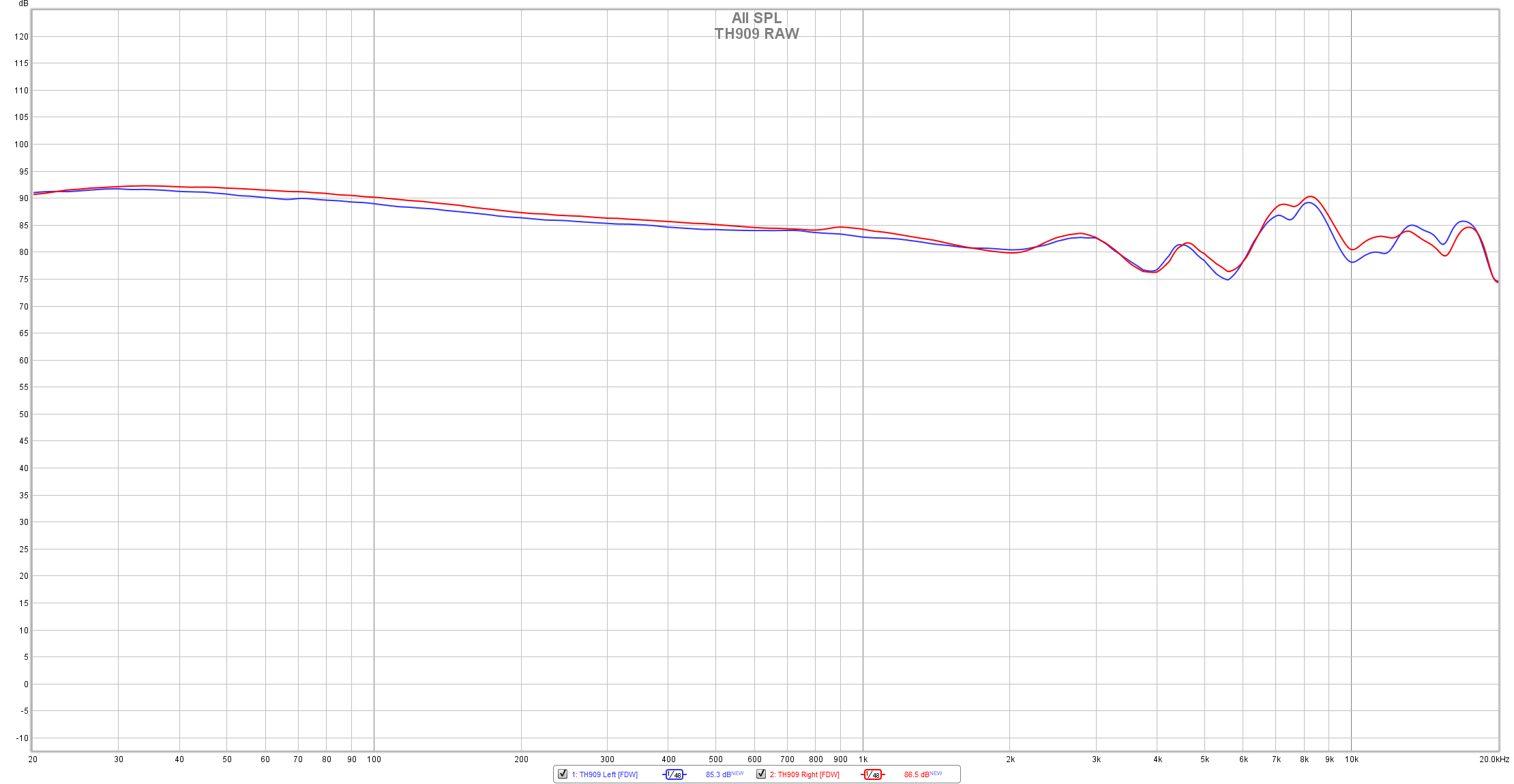
These are their RAW measurements without any kind of smoothing applied. Driver matching is good, frequency response is very much the same that I have described in the previous chapters and sincerely I am not surprised to see it this way. There is a small deviation in the treble region, but nothing to be worried about. As you can see, TH-909 was tuned towards a super-fun and hard-punching experience with bass and treble taking a step forward.
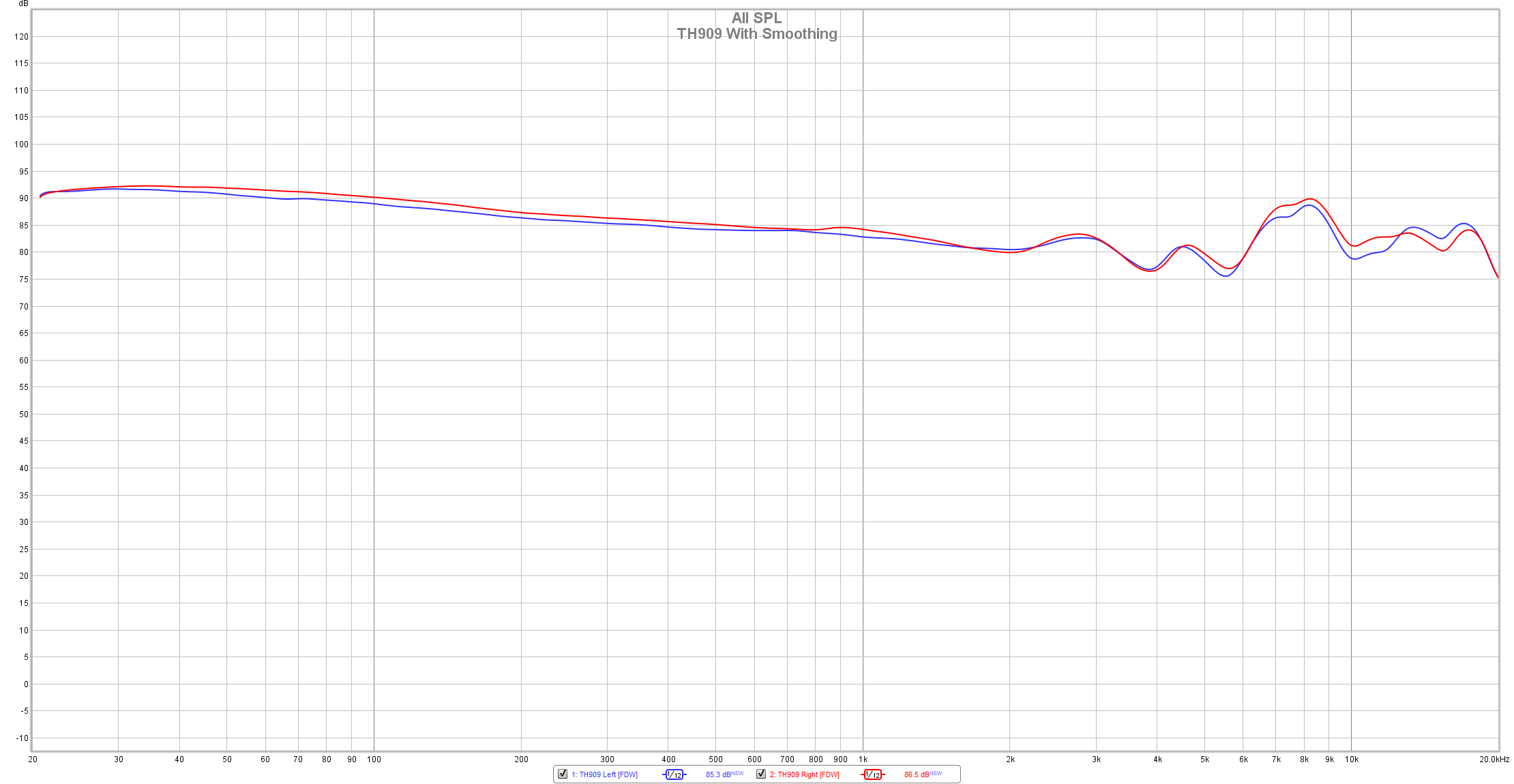
Applying a gentle 1/12 smoothing, not a lot of things are changing. Do note that I’ve sent 85 dB sine-waves towards them and you can clearly see how much they deviate from that signal in the bass and treble area. The whole sub-bass region is elevated by 6-7 dB and mid-bass is elevated somewhere between 4 and 2 dB. Midrange feels very close to my linearity curve, it’s perfect by my standards and the treble is by a hair elevated in the most sensitive part of our hearing.
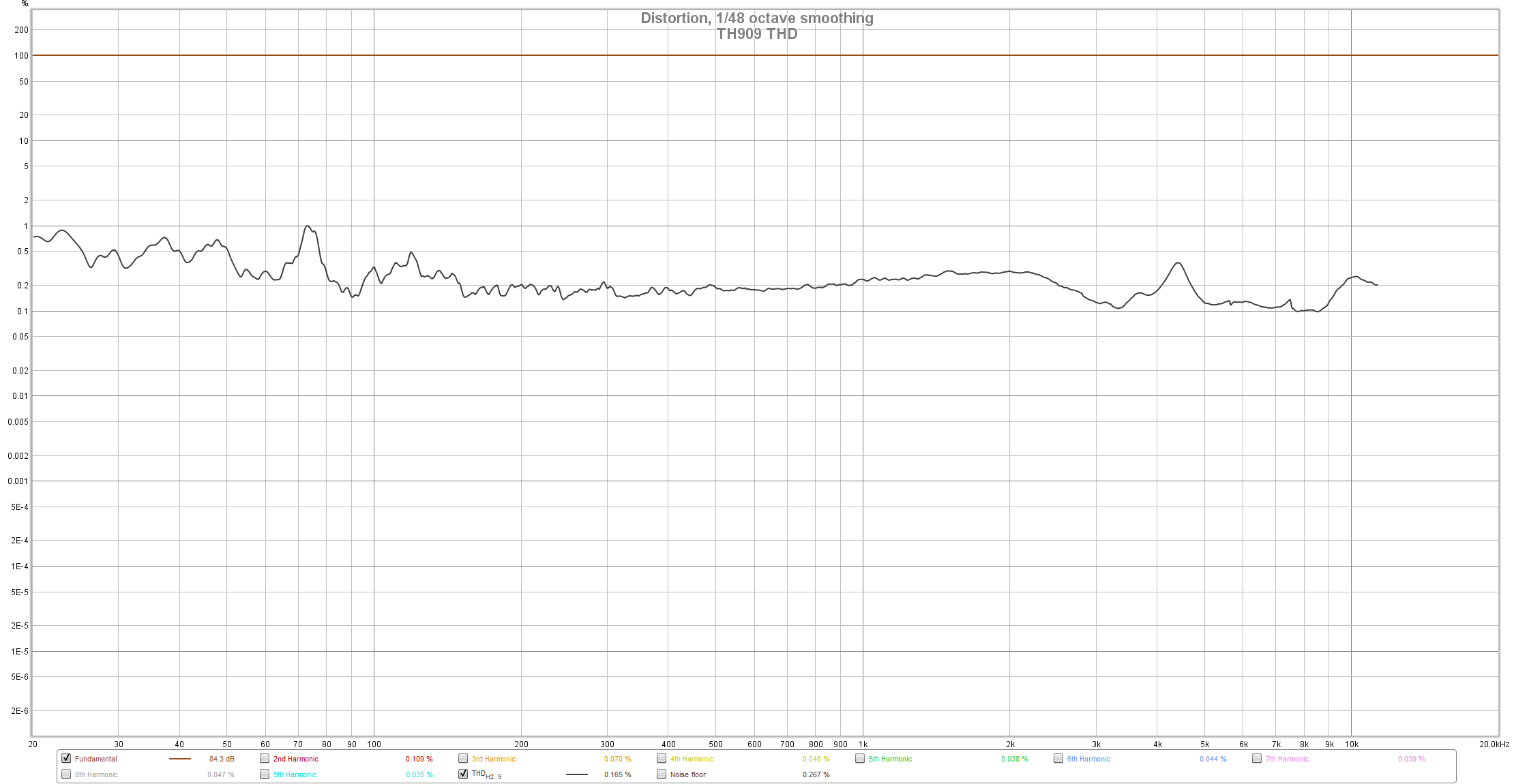
Their Total Harmonic Distortion (THD) is extremely impressive, at just 0.16% THD this is the lowest I’ve recorded so far, with any headphones, including ones that are costing 3 times their price. Notice the super-low distortion in the treble, very impressive if you ask me.
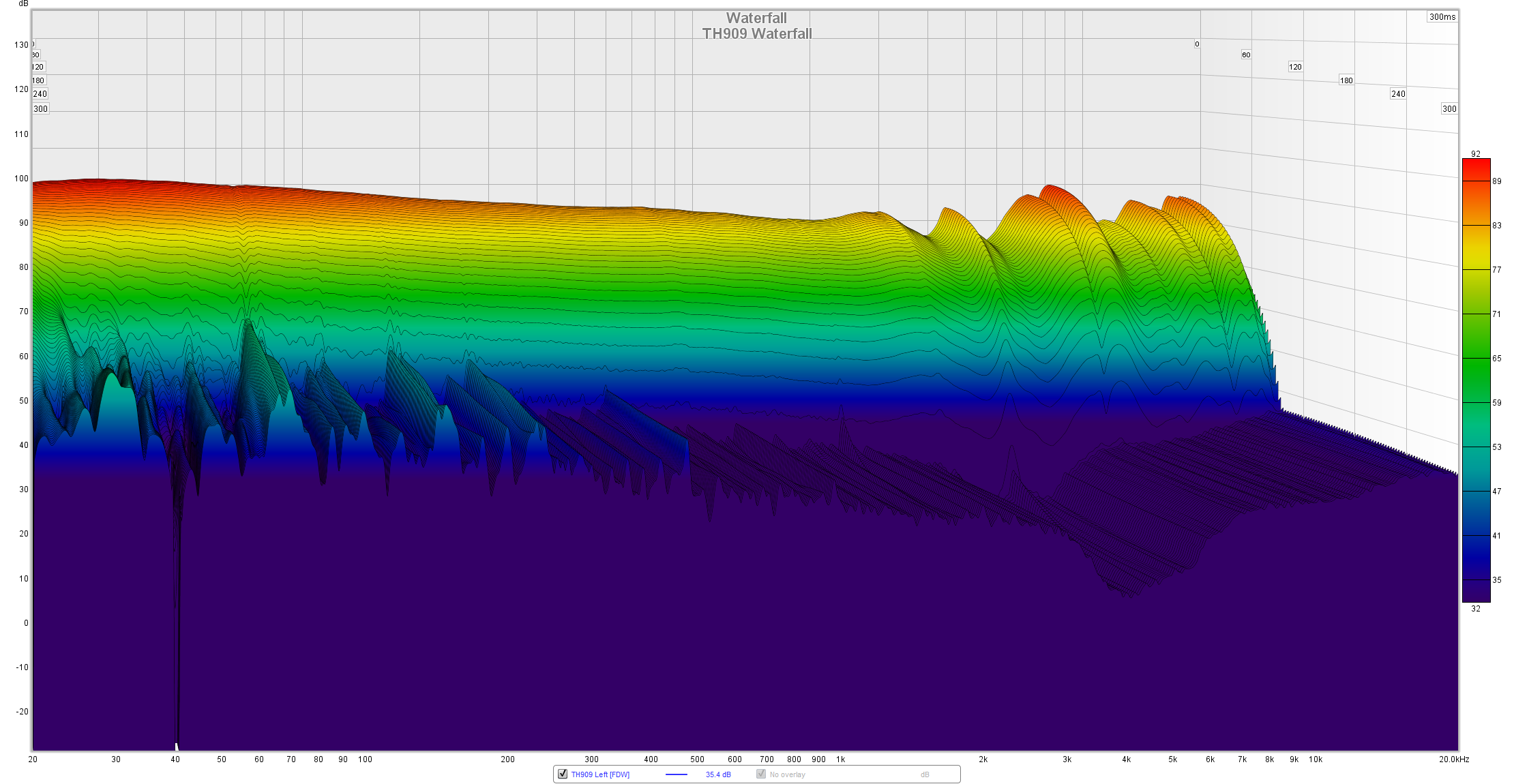
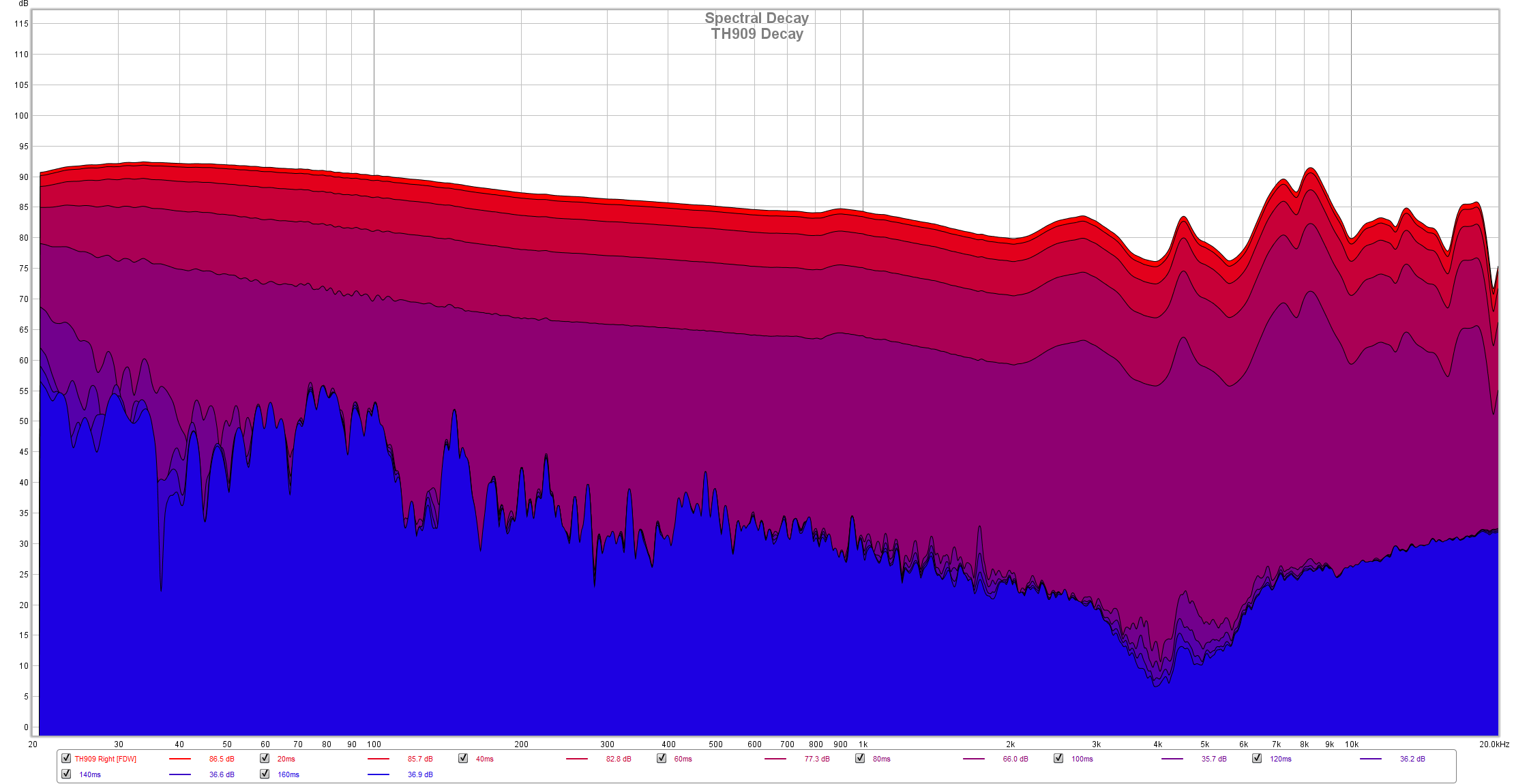
Waterfall and spectral decay are showing a super-short driver vibration and an instant decay of the notes, especially the treble decay feels lightning fast, which is exactly what I’ve experienced while listening to them.

Spectrogram is not showing some weird driver movements in the bass, which is nice to experience and you can clearly see the hot zones (Red) and the smaller dips (Green) in the FR.
All in all, I’ve recorded a nice driver matching, the best sub-bass performance that feels a little bit overdone, a linear midrange and a very good treble performance for an extended frequency response. They measured considerably better than a lot of headphones costing 2 to 3 times their price.

Conclusion
This is my first contact with Fostex headphones at my place and hopefully it will not be my last. Fostex added some unique ingredients in here that other dynamic headphones simply don’t have and as such they sounded unlike anything else. They checked a lot of boxes for me, I’m yet to hear some headphones that would sound as fast, will pound as hard and would move my body as much. These felt like undefeated champions when it comes to transient response and sub-bass delivery in an open-back headphone. I really dig their looks and I can’t get enough of that beautiful lacquer finish. TH-909 is a comfortable headphone that is build to last, even its cable seems to be well made, with high-purity copper conductors and high-quality jacks that will protect long term against oxidation.
Most importantly, they offered the highest enjoyment factor and some of the best dynamics I’ve experienced. They also challenged my other headphones in terms of measurements like distortion, spectral decay and frequency response. In reality there isn’t much to nitpick about these except for their slight V-shape in the frequency response.
Considering how much fun I had with them, their lightning speed and immaculate measurements, it’s my pleasure to award them our highest Golden Award.

TH-909 is a statement open-back dynamic headphone and as a flagship product, they will cost you a pretty penny. More exactly $1799, you can get them from here and if you hurry up, there are several refurbished pairs sold for $1299 that you can get from here.
PROS:
- Amazing packaging, a headphone stand is also included
- They look gorgeous, with those nice ear-cups
- Lightweight and comfortable long term
- Good cable quality with high-quality conductors inside
- Extremely easy to drive, you don’t even need desktop power to drive them properly
- Very detailed and transparent sounding
- Good soundstage and an amazing depth performance, 3D sounding with the right music
- Impressive measurements and very extended frequency response
- Simply the best transient response I’ve experienced, they sound fast and pound hard
- Bottomless bass and extended treble performance
- Fast decays, notes will not linger for a micro-second longer
- A really nice value if you ask me
CONS:
- No hard-case in the package
- I had too much fun with these, it’s almost illegal
ASSOCIATED EQUIPMENT:
- Sources: Xiaomi Mi 9T Pro, Corsair One i160
- DACs: Audiobyte HydraVox + HydraZap, Matrix Audio Element X, Mini-i Pro 3, Soncoz SGD1, Aune Audio S8, Burson Conductor 3X Performance, Flux Lab Acoustics FCN-10
- DAPs: Shanling M6, FiiO M15
- Headphone Amps: Benchmark HPA4, SparkoS Labs Aries, Flux Lab Acoustics FCN-10, LittleDot MKIII SE
- Integrated Amps: KECES E40
- Power Amps: KECES S300, Kinki Studio EX-M7
- IEMs: FiiO FA9, FH7, Meze Rai Penta, Rai Solo & lots of other lower tiered ones
- Portable headphones: Sennheiser Momentum 2, Meze 99 Classics
- Wireless headphones: Sony WF-1000XM3, Sennheiser Momentum 3, Master&Dynamic MW65
- Full-sized headphones: Fostex TH-909, Hifiman Susvara, Hifiman Arya, Audeze LCD-4, Erzetich Phobos, Erzetich Mania, Quad ERA-1, Ollo S4X Reference, Kennerton Wodan, Magni & Gjallarhorn
- Loudspeakers: Buchardt S400
- Interconnects: QED Reference (x2), Aune AL3
- Speaker cables: Kimber PR8, Audioquest Type4
- Power Cables: Isotek EVO3 Premier (x3)
- Balanced Isolation Power Conditioners: PLiXiR Elite BAC400, KECES BP-600
